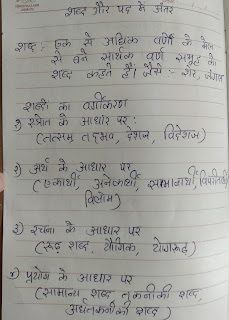science chapter note of 12.sound
Sound
Sound is a form of energy which produces a sensation of hearing in our ears.
Production of Sound
Sound is produced due to the vibration of objects.
Vibration is a periodic back-and-forth motion of the particles of an elastic body or mediumkind about a central position. It is also named as oscillation.
For example:
Vibration is a periodic back-and-forth motion of the particles of an elastic body or mediumkind about a central position. It is also named as oscillation.
For example:
- Stretched strings of a guitar vibrate to produce sound.
- When membrane of a table is struck, it vibrates to produce sound.
Propagation of Sound
- The travelling of sound is called propagation of sound.
- Sound is propagated by the to and fro motion of particles of the medium.
- When an object vibrates, the particles around the medium vibrate. The particle in contact with the vibrating object is first displaced from its equilibrium position. Each particle disturbs the other particle in contact. Thus, the disturbance is carried from the source to the listener.

Only the disturbance produced by the vibrating body travels through the medium but the particles do not move forward themselves.
Medium
- The matter or substance through which sound is transmitted is called a medium.
- A medium is necessary for the propagation of sound waves.
- The medium can be solid, liquid or gas.
- Sound cannot travel in vacuum.
Wave that requires medium to propagate is called Mechanical wave.
Wave
Wave is a phenomenon or disturbance in which energy is transferred from one point to another without any direct contact between them. For example: Heat, light and sound is considered as a wave.
Types of Waves
On the basis of direction of propagation, waves are categorized into two parts:
(i) Longitudinal waves:
These are the waves in which the particles of the medium vibrate along the direction of propagation of the wave. For example: sound wave.
(ii) Transverse waves:
In this type of wave the particles of the medium vibrate in a direction perpendicular to the direction of propagation of the wave. For example: waves produced in a stretched string.
Another type of waves which do not require any medium for propagation are called electromagnetic waves. These waves can travel through vacuum also. For example, light waves, X-rays.
Compressions and Rarefactions:
- Compression is the part of wave in which particles of the medium are closer to one another forming the region of high pressure and density.
Compressions are represented by the upper portion of the curve called crest.
- Rarefaction is a part of the wave where particles spread out to form a region of low pressure and density.
Rarefactions are represented by the lower portion of the curve called trough.

Characteristics of a sound wave
Sound waves have following characteristics:
(1) Amplitude
(2) wavelength
(3) Frequency
(4) Time period
(5)Velocity
Amplitude
- The maximum displacement of each particle from its mean position is called amplitude.
- It is denoted by A.
- Its SI unit is metre (m).
Wavelength
- The distance between two nearest (adjacent) crests or troughs of a wave is called its wavelength.
- It is denoted by the Greek letter lamda (λ).
- Its SI unit is metre.
Frequency
- The number of vibrations per second is called frequency.
- The SI unit of frequency is hertz (Hz).
- The symbol of frequency is ν (nu).
Time period
- The time taken to complete one vibration is called time period.
- It is denoted by T.
- Its SI unit is second (s).
- The frequency of a wave is the reciprocal of the time period.
i.e., v = 1/T
Velocity
- The distance travelled by a wave in one second is called velocity of the wave or speed of the wave.
- Its S.I. unit is metres per second (m/s).
- Velocity = Distance travelled/Time taken
⟹ v = λ/T , where λ = wavelength of the wave travelled in one time time period T)
⟹ v = λv (As 1/T = v)
Thus, Velocity = Wavelength × Frequency
v = λv is called the wave equation.
Pitch and loudness of Sound
Pitch: It represents shrillness or flatness of sound.
It depends on the frequency of vibration. Higher the frequency of sound wave, the higher will be the pitch of sound and vice-versa.
Loudness: It is a measure of the sound energy reaching the ear per second.
It depends on the amplitude of the sound wave.
It is measured in decibel ‘dB’.
Music And Noise
Music: It is the sound that is pleasant to hear. For example: Sound coming out of musical instruments)
Noise: It is the sound that is unpleasant to hear. For example: Sound produced by vehicles.
Tone and Note
Tone: A pure sound of single frequency is called tone.
Note: An impure sound produced by mixture of many frequencies is called a note. For example: A musical note has tones of various frequencies.
Audible Frequency
The audible range of human ear is 20 Hz and 20,000HZ, i.e., the human ears can hear only those waves whose freqnecy lies between 20 Hz and 20,000HZ.
